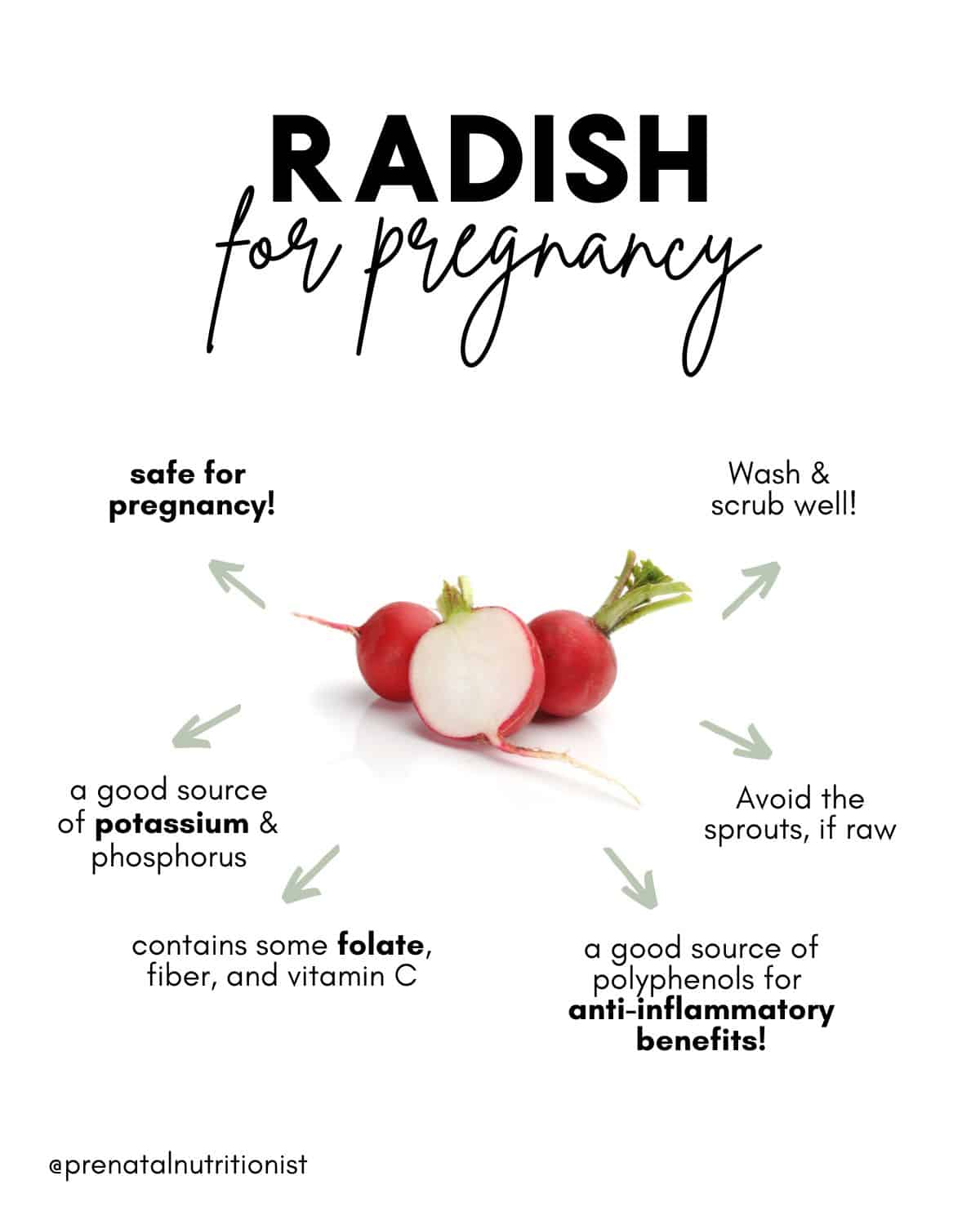Radishes are root vegetables, along with other veggies such as beets, carrots, rutabaga, and turnips. There are many different types of radishes, such as daikon radish, French Breakfast, Green Meat, Cherry Belle, Watermelon, Malaga (yes, these are all real varieties!), etc. They all come in different shapes, sizes, and colors!
You can almost always find the popular ‘red radish’ at the grocery store, but some of the others may be more seasonal and likely found at Farmer’s Markets. Like squash, some grow better in the winter and others in the spring. So really, you can find different varieties of radishes all year round!
Are (all) radishes safe to eat during pregnancy?
Mostly, yes!
One concern with radishes is that they (like other root crops) are said to be at a higher risk of being grown in soil contaminated with Toxoplasma gondii, which are parasites that can cause toxoplasmosis, which is a dangerous infection in pregnancy (1, 2). This infection can lead to developmental problems, miscarriage, or even stillbirth.
However, washing radishes thoroughly is one way to reduce this bacteria, as well as others, which can contaminate a raw radish during processing.
As long as you wash radishes well before eating, you can eat them (along with other root crops) while pregnant. We will go over a few more safety precautions in the section after next!
What about radish sprouts??
As with all sprouts, it is ideal to avoid raw radish sprouts during pregnancy since they carry a high risk of being contaminated with Salmonella, Listeria, and E coli.
Therefore, radish sprouts should only be eaten if they are thoroughly cooked by steaming, boiling, or baking. Wash and cook radish sprouts until 165 degrees Fahrenheit; this way, they can be safely eaten during pregnancy.
What safety measures should I take before eating radishes?
Before eating radishes, it’s recommended that you implement these safety measures as an extra means of caution before consuming: (3)
1. Scrub and wash the radishes thoroughly under running water, ideally with a vegetable brush, before eating them. A ‘produce wash’ is not necessary.
2. Cut off any bruised, browned, or damaged areas as these are areas known to breed bacteria. Discard any radishes that look overly brown.
3. If you are concerned about raw radishes, cooking them will further reduce the risk of making you sick. You can cook them by steaming and cooking them or adding them to soups, stews, sauteed dishes, or baked goods. See the last section for recipe ideas!
 Nutrient breakdown of radishes
Nutrient breakdown of radishes
½ cup radishes, raw (58 grams) (USDA)
Energy: 9.23 kcal
Protein: 0.4 g
Total fat: 0.1 g
Carbs: 1.97 g
Fiber: 1 g
Calcium: 14.5 mg
Magnesium: 5.8 mg
Phosphorus: 11.6 mg
Potassium: 135 mg
Vitamin C: 8.6 mg
Folate: 14.5 ug
What benefits do radishes have for pregnancy?
Polyphenols. Radishes are rich in non-flavonoid polyphenols and glucosinolates (4). These compounds provide anti-oxidative and anti-inflammatory benefits to repair damaged cells and lessen conditions associated with increased oxidative stress, including miscarriage and preeclampsia (5, 6).
Potassium is an essential mineral and electrolyte that supports normal fluid balance, hormone production, protein formation, heart function, and blood pressure.
Vitamin C is not only essential for supporting immunity and skin health, but Vitamin C plays a vital role in the development of the fetus’s brain. It also helps regulate blood sugar and support collagen synthesis (7, 8).
Vitamin C also helps regenerate vitamin E, another vitamin that acts as an antioxidant (9).
Phosphorus. Getting enough phosphorus is necessary to support your baby’s skeleton development, cell function, and regulation of blood sugar levels (10). Not getting enough phosphorus during pregnancy has been associated with an increased risk of preeclampsia (10). A ½ cup of raw radishes provides almost 12 mg of phosphorus to contribute to your daily intake.
A small amount of fiber. Radishes provide some fiber (1.6 grams per 100-gram serving) to help meet your daily recommended intake of 30 grams per day during pregnancy.


I include radishes in my pregnancy diet?
Radishes do not have a strong flavor but can add a colorful crunch to many dishes! As discussed at the beginning, there are so many radish varieties to choose from, so get creative, and try to venture out of your comfort zone.
Ideas for including radishes in your daily meals and snacks include:
- Sliced over salads
- Sliced on top of avocado toast
- Dipped into hummus, pesto, or tzatziki
- Mixed into greek yogurt with cucumbers and dill
- Baked as radish chips
- Baked with butter on a baguette
- Roasted and dipped in ranch
- Sauteed with bacon
The Bottom Line
- Radishes are safe to consume during pregnancy, and with a few safety precautions, they can carry even fewer risks for you and baby.
- Scrub and wash the radishes thoroughly under running water, ideally with a vegetable brush, before eating them.
- Cut off any bruised, browned, or damaged as these are areas known to breed bacteria, and discard any radishes that look too brown. If you are concerned about raw radishes, cooking them will further reduce the risk of getting sick. You can cook them by steaming and cooking them or adding them to soups, stews, sauteed dishes, or baked goods.
- Radishes contain polyphenols, vitamin C, potassium, phosphorus, and fiber, which all support your and your baby’s health and well-being during pregnancy.
Written by: Claire Gilmore, MSCN, CNS, LDN, and Ryann Kipping, MPH, RDN, Owner + Founder


